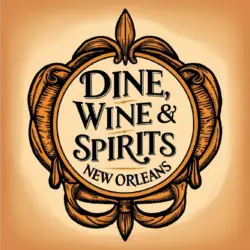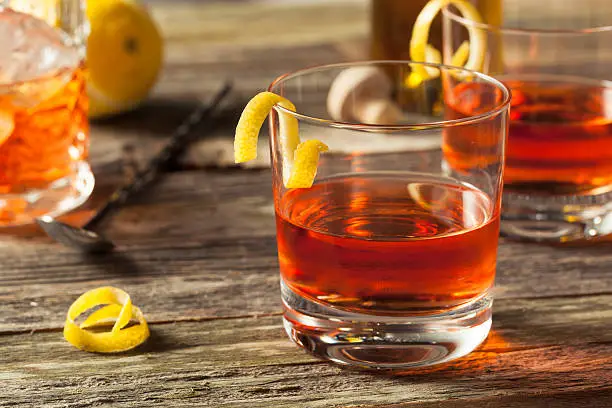Sazerac Cocktail
The Whole Real Story
By Tim McNally
Let’s clear a local common misconception: the cocktail concept was not invented in New Orleans. This style of adult beverage, making use of fruit juice, spice or bitters and a spirit (or two), was actually created in England or New York, depending on who is providing the history.
There is still much discussion about how the term, cocktail, came to be affixed on the drink. Some have claimed the earliest versions were served in a coquetier, a French cup used to serve eggs. And that the name was a derivative of what Americans could pronounce. Coquetier became cocktail. Good story but not true.
More likely the term “cocktail” was the action and spices, notably ginger, that were placed up the back end of a racehorse causing the animal to keep its tail in the air during racing. The ingredients, not the ones previously used on the animal, were also incorporated into the mixed adult beverages served in taverns. All of this happened in the late 1700’s.
What is true, however, is that New Orleans was an early adapter and appreciator of cocktails. They were a breakfast favorite. Sort of a good-for-what-ails-you way to get your day going.
A special local favorite was created by a young pharmacist behind the counter at his Royal Street apothecary in the early 1840’s. Antoine Amédée Peychaud, a Creole from Saint-Domingue, now known as Haiti, concocted the bitters that bear his name to this day. Bitters are an intense blend of various spices and fruit essences used to add flavors or aromas to whatever is being prepared, usually a beverage or a food recipe.
Peychaud probably created his start-the-day drink without adding any alcoholic spirit. Then in the late 1840’s he decided that the drink’s recipe lent itself to become a member of the “new” category of cocktails, adult beverages.
Since he now had a popular drink served only at his pharmacy in both alcohol and non-alcohol forms, he felt that he needed to distinguish the two versions. Can’t have the kids being served an adult beverage, especially one as potent as his creation. In those times, unlike our time period, cocktails were not named. Drinks were served exclusively at the emporium where they were invented.
But Peychaud now had two styles of the same recipe, basically. So he came up with a revolutionary idea. The alcohol version of his creation would go by the name of its main spirit ingredient, which happened to be Sazerac de Forge et Fils Cognac. And because Peychaud’s neighborhood was French with a taste for a spirit which originated in Switzerland, Absinthe, he added a dash of that distinctive anise liqueur.
So was born in New Orleans the oldest named cocktail in the world, the Sazerac.
Yet, the road since the mid-1850’s has not been smooth or even logical. With the success of the Sazerac came a number of aspiring cocktails. The first in a very long line of derivative cocktails was the Brandy Crusta, still featured in a number of bars.
In the late 1800’s disaster struck the European agriculture community. The root louse attacked vineyards literally sucking the life out of the vines from deep in the soil. Vines underproduced fruit and then died a slow death. It was a long process to eradicate the pest from the soil which required fields to lay fallow for years. That was followed by the long maturation period to allow newly planted vines to establish themselves and then show maturation. All the while the liquid that would become wine was scarce.
Good fortune would smile upon New Orleans as regards finding the right ingredient to substitute for the key spirit in the Sazerac cocktail. New Orleans was a key seaport at the southern end of the great river which served America’s heartland. Through this place flowed the best of whiskey from Tennessee and Kentucky. New Orleans was awash in whiskey. And we liked it very much.
Out with the Cognac, unavailable at any cost, and in with another flavor enjoyed by thirsty natives, Rye Whiskey. The changeover was swift and painless. The beloved Sazerac was saved by a product that was already here. To this day, most Sazeracs served use Rye Whiskey as the base spirit. Interestingly, the name of the cocktail never changed. It was still called by the name of the Cognac.
Then came another challenge. Absinthe was popularly blamed for a culture of alcohol surplus. Since Absinthe is 45% alcohol by volume, a very high presence, not only is alcoholism a common reason for addiction, but also delusional acts of violence and self-destruction have been blamed on the spirit. The drink was even nicknamed “The Green Fairy” to account for the out-of-this-world mental effects. Vincent Van Gogn, the Post Impressionist master artist, and Toulouse Lautrec were both addicted to absinthe.
In the first decade of the 20th century, France, Switzerland, and eventually the U.S. passed laws banning the sale of Absinthe. Pastis and sometimes ouzo served as pale substitutes for absinthe in the Sazerac. So now two major and key ingredients in the Sazerac were no longer being used, and still the cocktail retained its popularity and original name.
The ultimate test was yet to come. In 1919, the US passed the 18th Amendment to the Constitution which prohibited the sale of any alcohol beverage anywhere in the Country. So began a period of 34 years of Prohibition during which obtaining a cocktail or any spirit was an illegal act.
The Sazerac, as we all know, survives and thrives to this day. In 2008, the Louisiana Legislature passed an Act naming the Sazerac as the Official Cocktail of New Orleans.
INGREDIENTS
1.5 oz Sazerac Rye Whiskey
1 sugar cube
3 dashes Peychaud’s Bitters
.25 oz Herbsaint
Lemon twist
PREPARATION:
Pack an Old-Fashioned glass with ice. In a second Old-Fashioned glass, place a sugar cube and add three dashes of Peychaud’s Bitters to it. Crush the sugar cube. Add 1.5 oz Sazerac Rye Whiskey to the glass with the Peychaud’s Bitters and sugar. Add ice and stir. Empty the ice from the first glass and coat the glass with .25 oz Herbsaint. Discard the remaining Herbsaint. Strain the whiskey / bitters / sugar mixture from the glass into the Herbsaint coated glass and garnish with a lemon peel.
If you wish, substitute equal quantity Sazerac De Forge Finest Original Cognac for Sazerac Rye Whiskey.
If you wish, substitute


Comments are closed